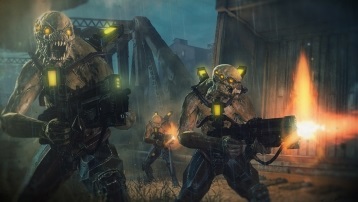The Importance of Making Players Feel Important

Everybody likes feeling important. It’s the reason why you’re more inclined to listen to someone if they address you as “Sir” or “Miss” as opposed to “Hey you” or “Listen, schmuck.” It’s the reason why older siblings often feel a heightened sense of responsibility for younger brethren. And it’s a powerful tool to draw players into your game and give it the time and effort it deserves.
“The deepest urge in human nature is ‘the desire to be important.’” –John Dewey
So how do you go about making your players feel important? There are many methods, and this is a topic well worth investigating in order to find the best ways to utilize its powers for your specific game. Here are a few universal tips to keep in mind when looking for ways to empower your players with almighty meaning.
Make Their Actions Matter
This is an obvious step considering the interactive nature of games, but it’s odd how often developers forget it. Say, for example, if the player’s able to empty round after round into farm animals with nary a grunt from each pig or goat, it’s basically the in-game equivalent of running around giving the finger to everybody and being ignored. In both situations, the subtext is clear: nobody in this game is paying attention to you.
Valve smartly realized the importance of implementing user feedback on behalf of the world during development of Half-Life, and this realization certainly contributed to that game’s groundbreaking sense of immersion when it was released.
“The second theory we came up with is the theory of player acknowledgment. This means that the game world must acknowledge players every time they perform an action. … Our basic theory was that if the world ignores the player, the player won’t care about the world.” –Ken Birdwell, Valve
This applies to the characters in your game as well. Of course, for this to capitalize on its potential, you need to create characters that are worth investing time into.
For example, Far Cry 3’s frequently maligned supporting cast of entitled rich party kids only serves as walking maguffins to rescue as you upgrade your skills and explore the game world. On the other hand, the support characters in any Metal Gear Solid game emit far more depth and relatability, despite mostly being confined to static codec screens and scripted conversations.
The key difference here is that outside of scripted interactions, the player has full control over when he decides to talk with them. Almost every time the player voluntarily calls a character for help or just to chat, he’s greeted with a unique interaction that fills out the game’s world, trickles in more of the character’s backstory, and strengthens the bond between the character and the player.
Make the Stakes Relevant
The country is under attack! The fate of the world is in danger! Some madman is threatening the universe! How many times have these grandiose, empty threats done exactly nothing to get you invested in whatever clichéd yarn a game is desperately trying to spin? Setting up an epic-scale conflict because it obviously begs the player’s interest is a naïve way to build a compelling story that’s sadly still overused.

Half-Life 2 does this well in the infamous “pick up that can” scene in the beginning. You have no other option but to comply with the guard’s request in order to continue, and that sense of powerless intentionally leaves you with a grudging resentment for the city’s authoritarian police force, making the eventual assault on the Combine even more satisfying. By taking the time to build meaningful stakes relevant to the player’s experience, Valve was able to cash this in for a satisfying payoff that made the player feel like a revolutionary.
Don’t Sideline the Player
If these tips seem like common sense, they pale in comparison to the obviousness of this one. While fans of certain genres tend to tolerate them better than others, using frequent, lengthy cutscenes or non-playable sequences of any kind is tantamount to ignoring the player. Veteran game designer Matthias Worch sums this up aptly in his GDC 2013 talk “Talking to the Player – How Cultural Currents Shape Game and Level Design”.
“Imagine this: You’re walking alongside somebody, engaged in a conversation… and just as you’re having this really interesting, deep exchange, the other guy abruptly grabs you by the arm and starts pulling and shoving you around, and he’s just ignoring everything you say from now on… Now, we wouldn’t put up with this in real life. Why would we let games do it?” –Matthias Worch
Worch’s analogy holds up remarkably well when you start looking at some well-known offenders. The frequent, interrupting cinematics in Max Payne 3 raised ire considering how consistently they halted gameplay, preventing players from reaching a more focused flow state. And this is from a story-heavy franchise known for its cutscenes!
Max Payne is a great example for this specific reason, and to explain another point: If you absolutely require non-interactive cutscenes, it’s a far lesser sin to use cinematics where the player’s character as he sees him in the game is not present. This refers to the player’s avatar as controlled by the player, versus other representations.
To elaborate: In the first two Max Payne games, you control a 3D avatar through a world and read comic book-style cutscenes portraying a human actor as the same character. Since you can’t control the actor, the disconnect between what you normally have control over (the 3D avatar) is not nearly as pronounced as it is in games with in-engine cutscenes (Max Payne 3), so the player doesn’t feel such a pronounced sense of being ignored.
Since you’re being shown something that the player otherwise wouldn’t be able to see, it doesn’t strike the same nerve that watching the avatar you’ve been controlling up to now suddenly start acting on his own. In the the case of the latter, the subtext is clear: the game doesn’t need you. And it’s certainly hard for anyone to feel important when you’re told you’re not needed.
Always Say Thank You (For Playing)
The player is always the most important character in any game. Taking time to make sure they feel like an empowered, vital piece of the experience you’ve lovingly crafted for them will do wonders in creating loyal fans eager to see what you’ll bring them next.
